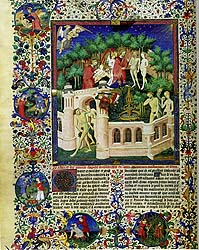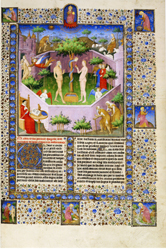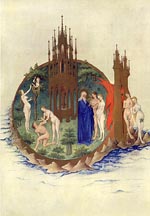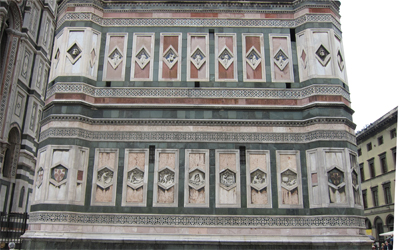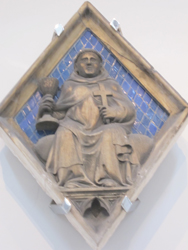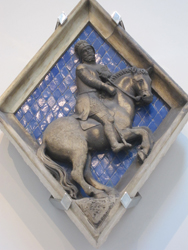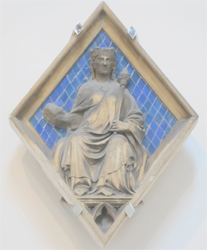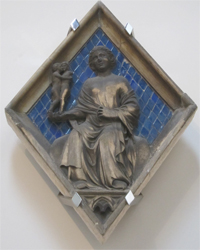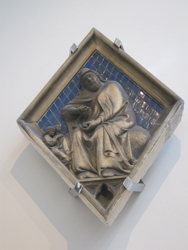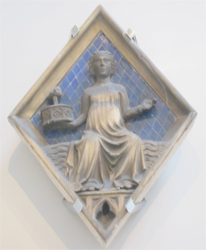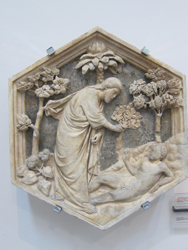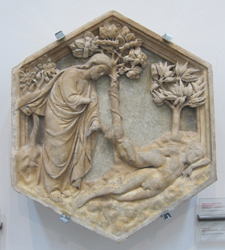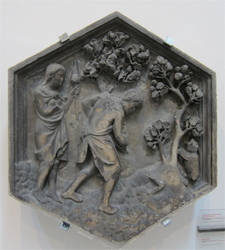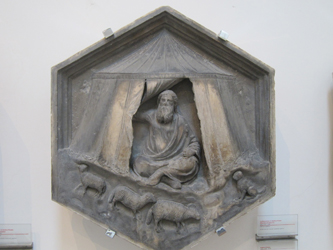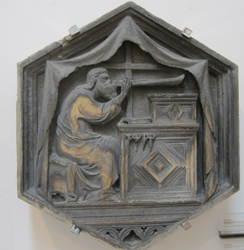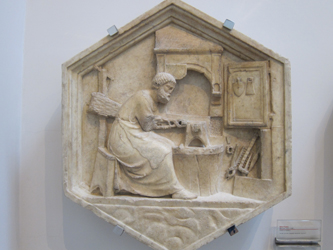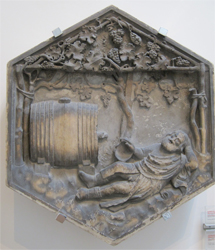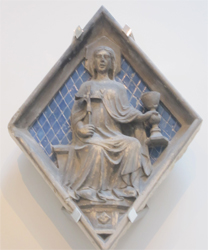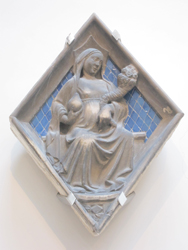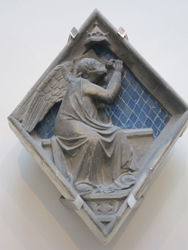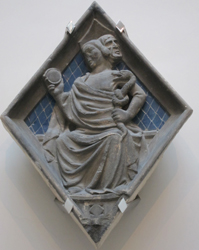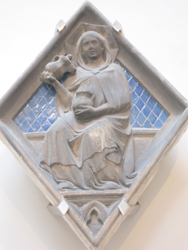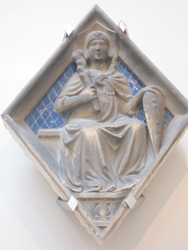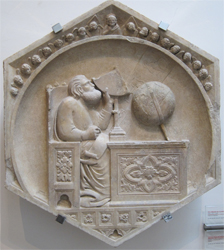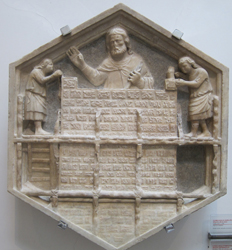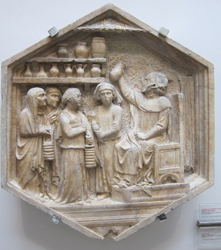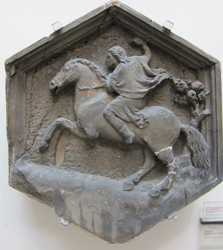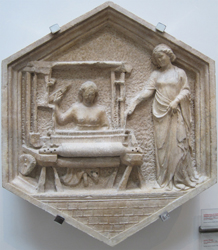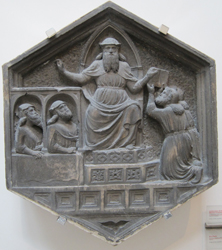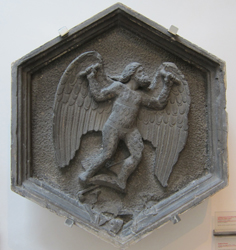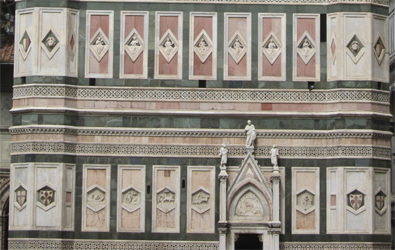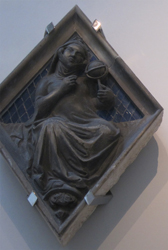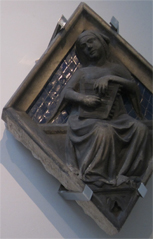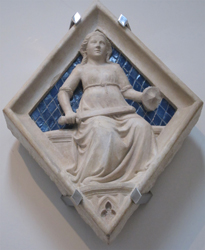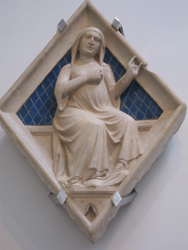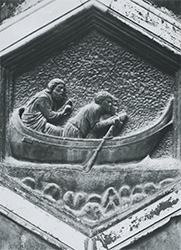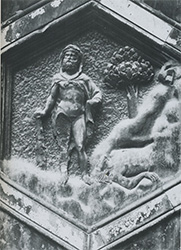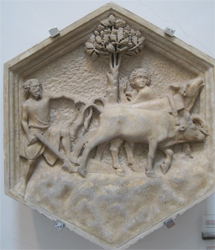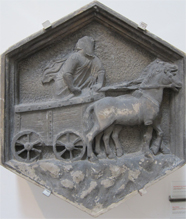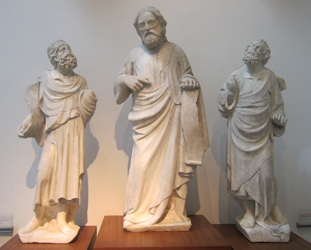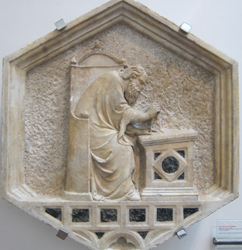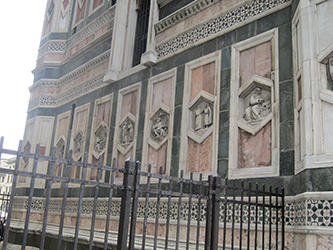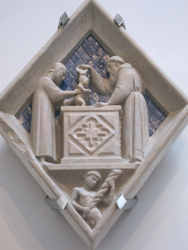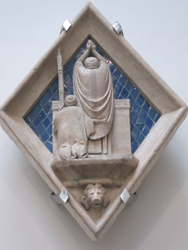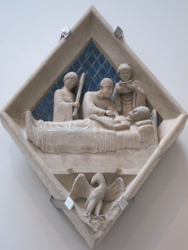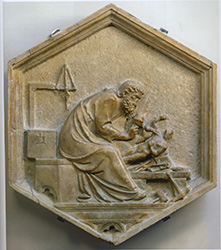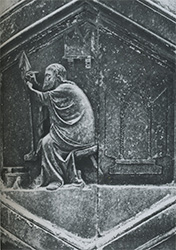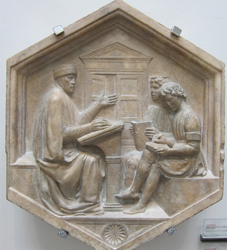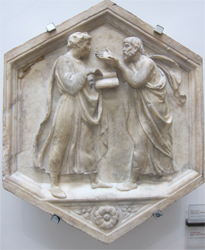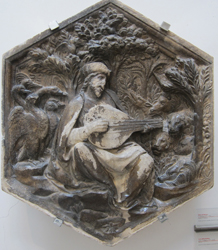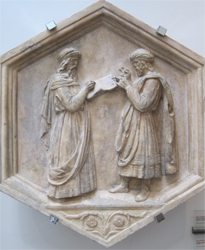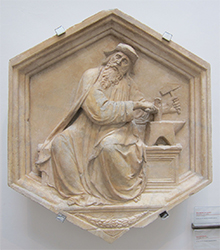ARTH Home | ARTH 213 | ARTH 213 Assignments
Campanile Reliefs
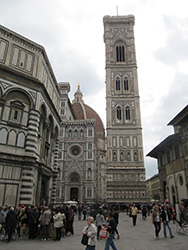 |
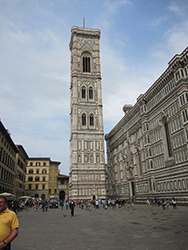 |
In 1334, Giotto was appointed the capomaestro for the construction of the Campanile or bell tower adjacent to the Duomo. On his death in 1337, Giotto was succeeded in the position by the sculptor Andrea Pisano who was in the last stages of the completion of the first set of Baptistry Doors. At the base of the Campanile there is a remarkable set of 54 reliefs --26 hexagonal and 28 rhomboid. There is still debate amongst scholars as to whether Giotto was responsible for the design of the program of reliefs. Vasari attributes to Giotto two panels: "in one of which Apelles, standing for painting, is working with his brush, while in the other Phidias, representing sculpture, is laboring with his chisel." The consensus today is that these two panels on the north side of the Campanile, while possibly following an original design of Giotto, are the work of Andrea Pisano. The reliefs show a remarkable convergence of cultural traditions. The figure of Hercules as the embodiment of social justice on the east side is a fourteenth century premonition of the interest in classical mythology and of the introduction of contrapposto that will appear in the sculpture of the beginning of the fifteenth century in the work of Donatello. The classical gods are represented in the series of planets on the west side. But here the classical figure is converted to late medieval imagery. For example, the figure of Jupiter is represented in the garb of a medieval monk, while Mars is visualized as a medieval knight. The facial and figure types of figures like Phidias on the north side are cousins of figures from French Gothic sculpture. At the same time Phidias is shown at work on a classical nude, a remarkable work for this period. The general iconographical scheme has been related to the French scholastic thought of Vincent of Beauvais and his Speculum Majus (the great mirror) which attempted to codify a cosmic plan for the universe. The division of the Speculum into four books intentionally echoes the culture's belief in numerology: four elements, four humors, four seasons, four evangelists, four corners of the world, etc. Vincent's four books are: The Mirror of Nature, The Mirror of Instruction (including both the seven Liberal Arts (grammar, rhetoric, logic, arithmetic, geometry, music, and astronomy) and the seven Mechanical Arts (construction, medicine, horsemanship, weaving, navigation, agriculture, and trade), The Mirror of Morals (including the Virtues and Vices), and The Mirror of History (Christian plan of history beginning with creation to final judgment). While the Campanile reliefs were undoubtedly influenced by the French scholastic thought, what is more striking is to observe how these reliefs are conceived of in relationship to values and interests of fourteenth century Florence. This is well illustrated by comparing the Genesis images on the west front of the Campanile to a group of fifteenth century Genesis images from French manuscripts.
Consider the specific details involving the different trades that are included in the reliefs. For example, the blacksmith shop shown in the west face's image of Tubalcain is full of details of specific tools, or the image of textile production on the south side gives a very detailed view of a loom, a machine that was central to Florence's economic prosperity. In the panel representing medicine consider the detailed representation of dress with the doctor wearing the characteristic dress of a late medieval doctor. The women carry the woven bags used typically to carry urine specimens. The reliefs balance the emphasis on the practice of the trades with the gaining of a theoretical understanding through the study of the liberal arts.
|
|
||||||
Planets |
||||||
Saturn: Collaborator of Andrea Pisano (Master of Saturn) |
Jupiter: Collaborator of Andrea Pisano (Master of Saturn), 1337-41. |
Mars: Collaborator of Andrea Pisano (Master of Saturn), 1337-41. |
Sun: Collaborator of Andrea Pisano (Master of Saturn), 1337-41. |
Venus: Nino Pisano, 1337-41. |
Mercury: Nino Pisano, 1337-41. |
Luna: Collaborator of Andrea Pisano (Master of Luna), 1337-41. |
Creation of Adam: Andrea Pisano, 1334-36. |
Creation of Eve: Andrea Pisano, 1334-36. |
Adam and Eve working after the Fall: Andrea Pisano, 1334-36. |
Jabal:
Andrea Pisano, 1334-36.
|
Jubal: Nino Pisano, 1334-36. |
Tubalcain: Nino Pisano, 1334-36. |
Noah: Collaborator of Andrea Pisano (Master of Noah), 1334-36. |
| Jabal was the son of Lamech and Ada, and he was the brother of Jubal and half-brother of Tubalcain. He is mentioned in Genesis 4:20: "And Ada brought forth Jabel; who was the father of such as dwell in tents, and of herdsmen." | Genesis 4:21: "And his [Jabal] brother's name was Jubal; he was the father of them that play upon the harp and organs." | Genesis 4:22: "Sella [the second wife of Lamech] also brought forth Tubalcain, who was a hammerer and artificer in every work of brass and iron...." | Genesis 9: 20-21: "And Noah, a husbandman, began to till the ground and planted a vineyard. And drinking of the wine was made drunk, and was uncovered in his tent." | |||
| Virtues | ||||||
Faith: Gino Micheli da Castello, 1337-41. |
Charity: Collaborator of Andrea Pisano (Master of Luna), 1337-41. |
Hope: Collaborator of Andrea Pisano (Master of Luna), 1337-41. |
Prudence: Collaborator of Andrea Pisano (Master of Armor), 1337-41. |
Justice: Collaborator of Andrea Pisano (Master of Armor), 1337-41. |
Temperance: Collaborator of Andrea Pisano (Master of Saturn), 1337-41. |
Fortitude: Collaborator of Andrea Pisano (Master of the Moon), 1337-41. |
Gionitus, the inventor of astronomy: Collaborator of Andrea Pisano (Master of Armor), 1334-1336. |
Architecture: Collaborator of Andrea Pisano (Master of Armor), 1334-1336. |
Medicine: Nino Pisano, 1334-36 |
Hunting: Andrea Pisano, 1334-1336 |
Textile Production: Andrea Pisano, 1334-36. [the woman on the right can perhaps be identified as Minerva, the inventor of weaving] |
Phoroneus, inventor of law: Nino Pisano, 1334-36. [Phoroneus was believed to have arbitrated a dispute between Hera and Poseidon. ] |
Daedalus: inventor of arts: Andrea Pisano, 1334-36 |
